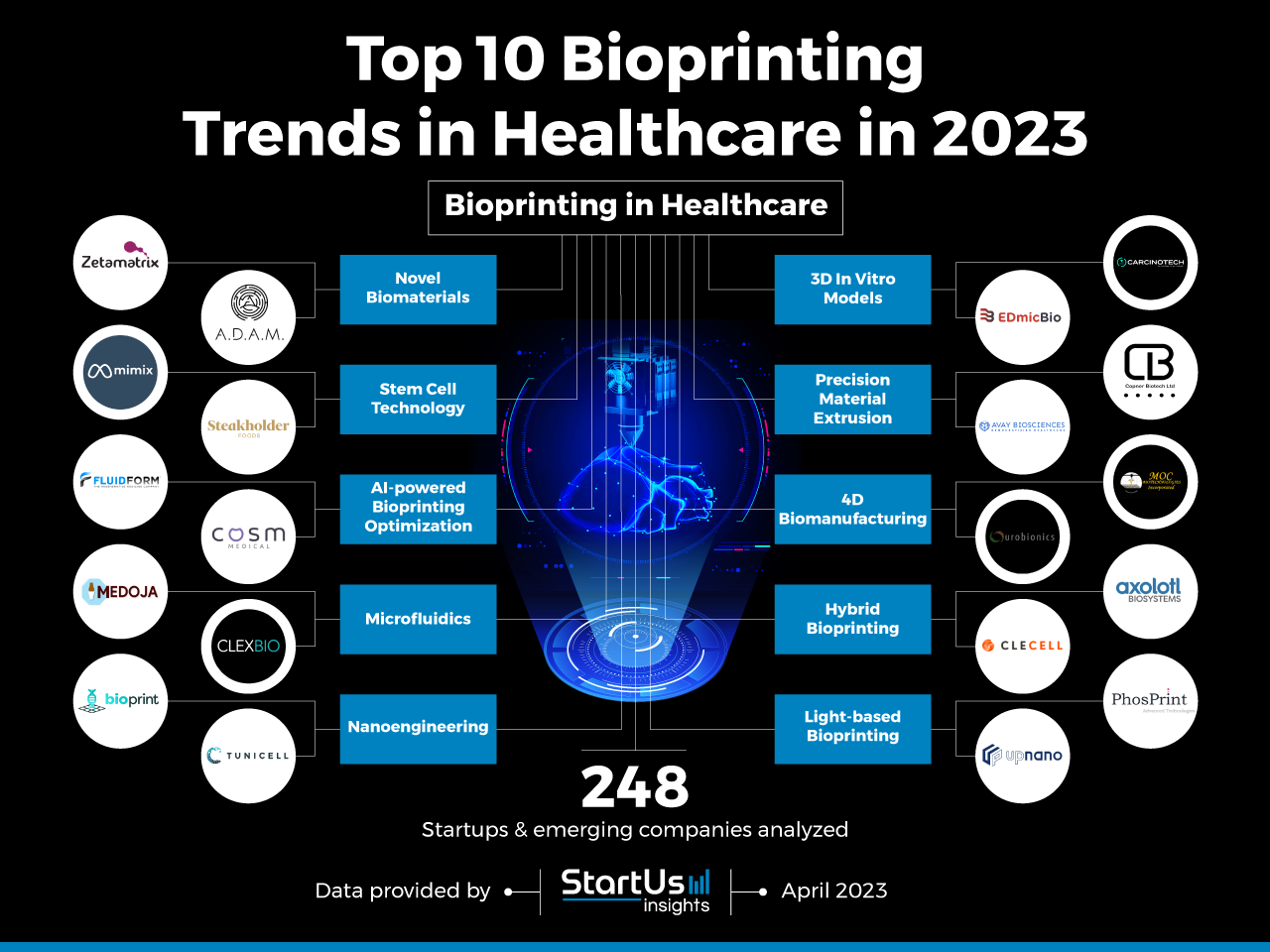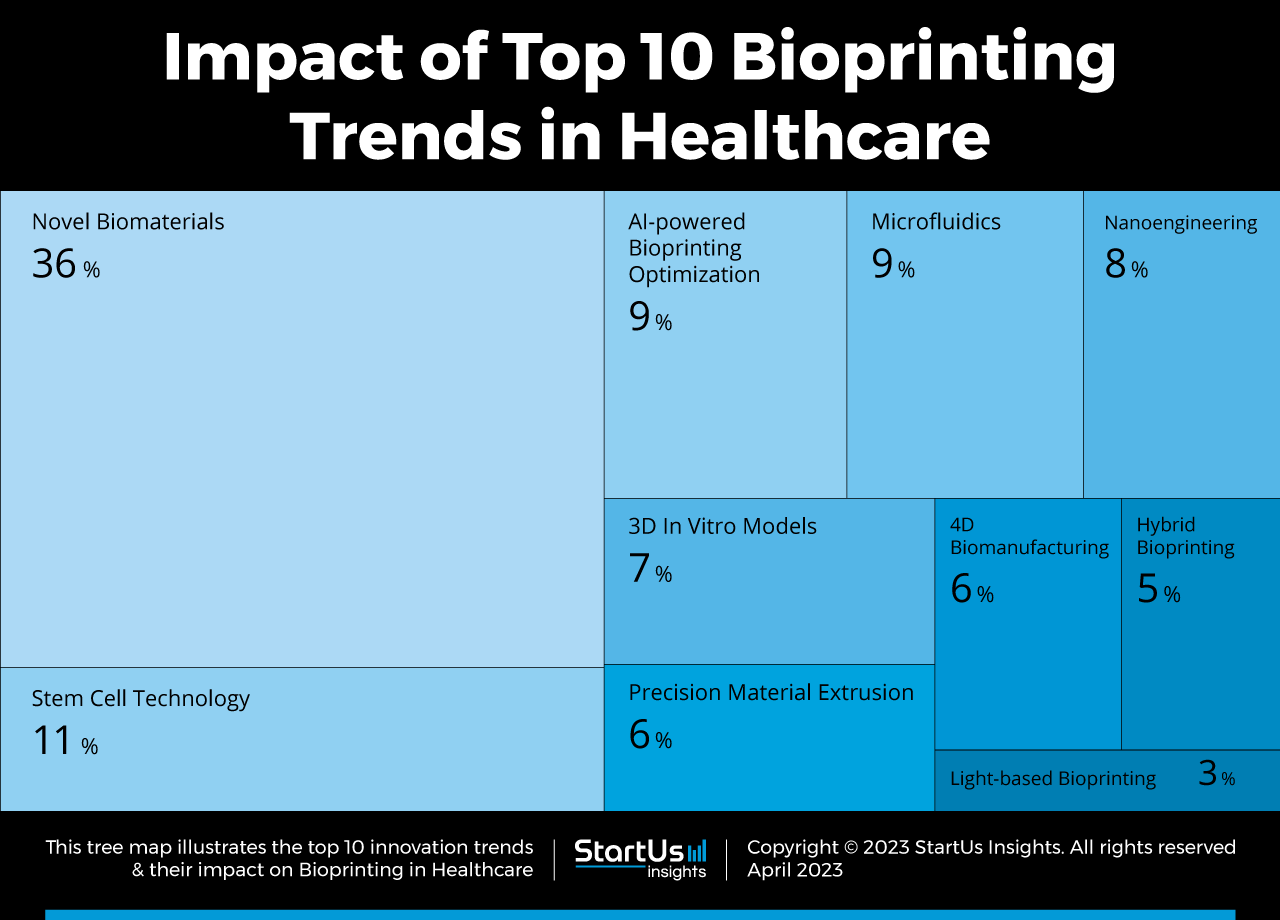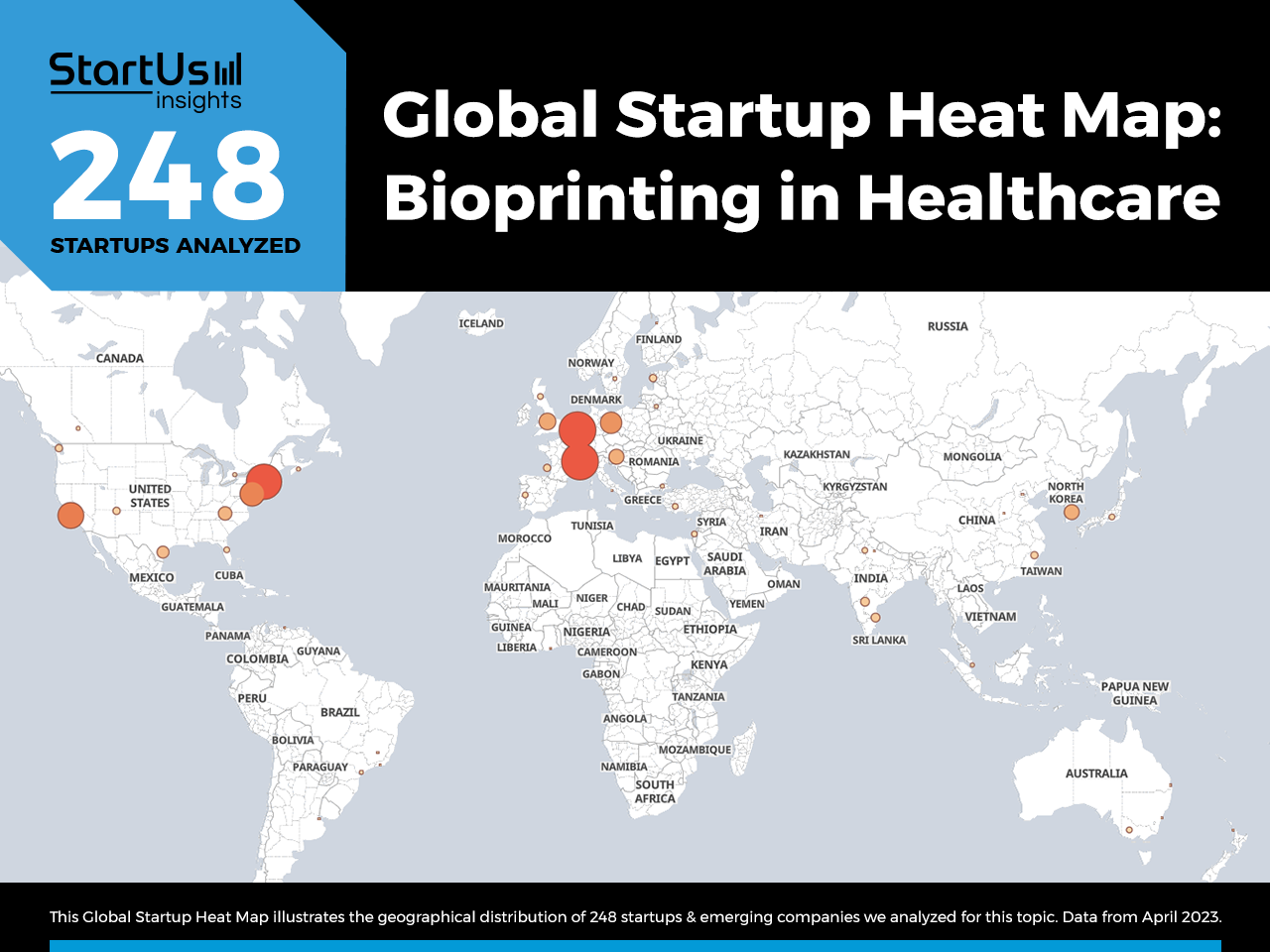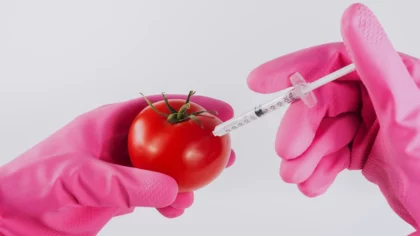Accelerate Productivity in 2025
Reignite Growth Despite the Global Slowdown
Bioprinting technology holds significant potential for regenerative medicine and healthcare. It aims at addressing the scarcity of donor organs and personalization of medical treatments by creating 3D-printed living tissues or organs. However, bioprinting often faces challenges in reproducing the complex structures and functions of native tissues. Technological advancements such as novel biomaterials, new printing techniques, and AI-powered optimization help overcome these challenges. This article provides an overview of the top 10 global bioprinting technology trends and 20 innovative bioprinting startups. Read more to explore the latest developments in bioprinting that impact your business.
Innovation Map outlines the Top 10 Bioprinting Trends & 20 Promising Startups
For this in-depth research on the Top 10 Bioprinting Trends & Startups, we analyzed a sample of 248 global startups & scaleups. This data-driven research provides innovation intelligence that helps you improve strategic decision-making by giving you an overview of emerging technologies in the healthcare industry. In the Bioprinting Innovation Map below, you get a comprehensive overview of the innovation trends & startups that impact your company.
These insights are derived by working with our Big Data & Artificial Intelligence-powered StartUs Insights Discovery Platform, covering 3 790 000+ startups & scaleups globally. As the world’s largest resource for data on emerging companies, the SaaS platform enables you to identify relevant technologies and industry trends quickly & exhaustively.
Tree Map reveals the Impact of the Top 10 Bioprinting Trends
Based on the Bioprinting Innovation Map, the Tree Map below illustrates the impact of the Top 10 Bioprinting Trends. Startups and scaleups are incorporating novel biomaterials to create realistic and durable biological structures. This is followed by stem cell technology, which prolongs the lifespan of printed tissues crucial for patients awaiting organ transplantation. Further, AI-powered optimization enhances the quality of the final product by reducing time and processing costs. Microfluidics solutions offer better flow control of biomaterials, while nanoengineering augments their strength and resilience. 3D in vitro models also assist researchers in gaining a deeper understanding of disease mechanisms and the development of new treatments. In addition, 4D biomanufacturing allows researchers to create dynamic and adaptable biological structures that respond to the body’s needs. Hybrid and light-based bioprinting innovations contribute to the accurate elaboration of intricate and complex structures in a fast and efficient manner.
Top 10 Bioprinting Trends to Follow in 2023
- Novel Biomaterials
- Stem Cell Technology
- AI-powered Bioprinting Optimization
- Microfluidics
- Nanoengineering
- 3D In Vitro Models
- Precision Material Extrusion
- 4D Biomanufacturing
- Hybrid Bioprinting
- Light-based Bioprinting
Global Startup Heat Map covers 248 Bioprinting Startups & Scaleups
The Global Startup Heat Map below highlights the global distribution of the 248 exemplary startups & scaleups that we analyzed for this research. Created through the StartUs Insights Discovery Platform, the Heat Map reveals high startup activity in Europe, followed by the US and South Korea. Below, you get to meet 20 out of these 248 promising startups & scaleups as well as the solutions they develop. These bioprinting startups are hand-picked based on criteria such as founding year, location, funding raised, & more. Depending on your specific needs, your top picks might look entirely different.
Top 10 Bioprinting Innovation Trends for 2023
1. Novel Biomaterials
In recent years, novel biomaterials have been increasingly used in 3D bioprinting. These materials address various challenges including the strength and stability of structures, as well as their biocompatibility and bio-functionality. Some of the latest innovations involve composite materials, hydrogels, decellularized extracellular matrix (ECM)-based materials, and ingredients with biomimetic structures that resemble natural tissues. The benefits of these developments are particularly significant for stakeholders in the fields of regenerative medicine, drug discovery, and toxicology testing. By enabling the creation of more physiologically accurate models, novel biomaterials provide cost-effective manufacturing of low-volume or customized parts based on individual patient needs.
Zetamatrix offers Customized Hydrogels
Dutch startup Zetamatrix develops natural biomaterials in the form of hydrogels that act as ECM. The startup produces Gelma hydrogels through a chemical reaction between Gelatin and methacrylic anhydride. These biomaterials provide cells with an optimal biological environment to support cell growth and proliferation. Further, they are suitable for photo cross-linking that grants additional shape fidelity and stability at the physiological temperature. This way, Zetamatrix delivers ECM-mimicking biomaterials that allow bioprinting companies to replicate and reproduce specific tissues with better cell viability and versatility.
A.D.A.M. develops Biocompatible Biomaterials
A.D.A.M., a US-based startup initially founded in Ukraine, delivers patient-specific bioresorbable and biodegradable implants. Its patented 3D printers use ceramic bio-glass and modified biopolymers for fabricating flat and tubular bone implants. Using ceramic bio-glass, the startup ensures high bioactivity and porosity to stimulate osteogenesis and obtain bioresorbable implants. Meanwhile, modified biopolymers imitate natural bone structures useful for weight-bearing bones. It is also worth mentioning that biodegradable implants are replaceable by bone tissues and do not require reoperation in the long term. This results in fast-produced personalized solutions that improve patient outcomes and reduce healthcare expenses.
2. Stem Cell Technology
Numerous autologous or primary cell types are relatively difficult to isolate and culture in vitro due to their limited lifespan. Stem cell properties such as self-renewal and potency resolve such issues in 3D bioprinting. With stem cells, bioprinters create precise and controlled layer-by-layer assemblies of biomaterials in a desired 3D pattern. The latest advances contain induced pluripotent stem cells (iPSCs), mesenchymal stem cells, cultured meat, and others to enhance the quality and operability of bioprinted tissues. Additionally, this technology offers promising benefits, such as more functional and cost-effective disease models and organ fabrication.
mimiX Biotherapeutics applies Soundwaves to Stem Cells
mimiX Biotherapeutics is a Swiss startup that applies sound waves for living cell patterning through Sound Induced Morphogenesis (SIM) technology. Its product cymatiX uses SIM technology to replicate the pattern of cells, organoids, or tissue fragments into 3D constructs. Unlike conventional fabrication approaches, acoustic technology controls cell density enhancement and pattern formation. In conjunction with stem cells, this technology delivers skin grafts for acute and chronic wound treatment. The cells trigger local regeneration and enhance the closing of the wound surface. This way, mimiX Biotherapeutics provides faster regeneration, better relevance to the native tissue, reduced donor site, and enhanced tissue epithelization.
Steakholder Foods creates Stem Cell-based Meat
Steakholder Foods is an Israel-based startup that develops slaughter-free real meat by combining 3D bioprinting and advanced cellular biology. As commonly known, the production of meat and livestock farming are significant sources of greenhouse emissions. To overcome this, the startup’s proprietary technology selects the highest quality stem cells, places them in suitable conditions for growing, and differentiates them into muscle and fat cells. Afterward, muscle and fat cells turn into meat products, which are scalable through 3D bioprinting procedures according to personalized customer needs. This way, Steakholder Foods brings sustainable impact as well as desirable health outcomes, contributing to higher revenues in the long term.
3. AI-powered Bioprinting Optimization
The field of AI-powered bioprinting is an emerging area that has recently experienced significant advances. One such innovation is the ability of AI to accurately fine-tune various bioprinting parameters, which leads to faster printing times, improved resolution, and reduced risk of cell contamination. Startups also merge different types of machine learning algorithms to predict and optimize printing conditions. This way, AI-driven optimization provides more efficient approaches to developing personalized implants and meeting the needs of individual patients, researchers, and clinicians.
FluidForm prints AI-powered Functional Tissues
FluidForm is a US-based startup that applies AI algorithms to optimize the 3D biofabrication of human tissues and organs. Its FRESH (Freeform Reversible Embedding of Suspended Hydrogels) technology creates highly detailed, functional tissues that are useful for drug testing and transplantable organs. By connecting 3D printing, AI, and computational and synthetic biology, the startup prints proteins and cells native to the human body. Its new approach incorporates the bio ink-support bath interface that facilitates chemical interactions. Further, the FRESH technology aligns collagen with any 3D shape through pH-triggered gelation. By offering precise control and high-resolution, Fluid Form addresses the shortage of donor organs and the limitations of traditional cell cultures.
Cosm Medical provides AI-based Gynecological Prosthetics
Cosm Medical is a Canadian startup that leverages the advancements in ultrasound, AI, 3D printing, and cloud software to create custom-made designs for pelvic health disorders. Its proprietary platform Gynethotics takes manual finger measurements through ultrasound necessary for patient-specific designs. Then, the AI-driven cloud software processes data and images for prosthetics designed according to dynamic interactions between muscles, tissues, and ligaments of the pelvic floor. By doing so, AI enables clinicians to 3D print products, which were restricted by traditional stable designs. As a result, Cosm Medical’s AI and data-driven 3D printing solution enhances patient outcomes and treatment effectiveness in underserved and often stigmatized women’s health issues.
4. Microfluidics
The integration of microfluidics in bioprinting enables the creation of intricate structures with high accuracy. It also opens up bioprinting to a wide range of bio-inks with varying viscosities. With this technique, startups produce highly detailed constructs with precise geometries and controlled microenvironments. Microfluidic systems use small channels to change fluid behavior, allowing for accurate spatial positioning and switching between bio-inks with higher precision than traditional methods. This way, it enables scientists to replicate the cellular composition of the native tissue at the microscale, which is essential for fully functional and implantable organs.
Medoja Bio offers Microfluidic-synthesized Biomaterials
Medoja Bio is an Indian startup that synthesizes natural sources of waste such as marine, algae, and others into biomaterials through microfluidics. The continuous flow through microfluidic channels allows precise control over mixing and reaction times. Together with ball milling, spray drying, ultrasonication, and other methods, the startup manufactures customized nanomaterials. Further, Medoja Bio uses these 3D printable nanoparticle inks for bone regeneration and tissue engineering. This way, the startup recycles highly abundant waste into eco-friendly biomaterials, providing end-user products across several industries.
ClexBio offers Advanced Microfluidics
ClexBio is a Norwegian startup that combines advanced microfluidics and proprietary hydrogel techniques for tissue engineering and 3D bioprinting. Its CYTRIX Microfluidic Hydrogel Kit is a biocompatible bio-ink that allows the plug-and-play generation of defined, reproducible, and tailorable hydrogel microstructures for 3D cell bioprinting. The solution overcomes the challenges of existing traditional products such as clogging, fluctuating temperature control, or time-critical mixing procedures. Further, its VivoSet formulation enables centralized, high-throughput, and scalable tissue growth, recreating complex tissue geometries. ClexBio helps medical universities, researchers, and clinicians to test and fabricate user-specific transplants time-efficiently.
5. Nanoengineering
Nanoengineering in 3D bioprinting ensures the creation of biomimetic scaffolds that mimic the ECM of native tissues. Conventional synthetic materials used for bioprinting often have poor biocompatibility, contain toxic degradation products, and lack bioactive ligands. Alternatively, recent innovations include the use of nanocellulose as a bio-ink and the development of nanoclay-based hydrogels that enhance the printability of bio-inks and cell viability. Further, nanotechnology makes bio-inks more biocompatible with improved functionalities. Overall, nanoengineering in bioprinting delivers safer drug systems and partly reduces healthcare expenditures of transplantation materials for healthcare providers and patients alike.
BioPrint develops Fully Absorbable Implants
BioPrint, a startup from Brazil, utilizes nanoparticles in materials that enable full absorption by a body. Commonly, the availability of bone grafts for treating fractures is limited due to the lack of donors, storage, or poor compatibility. In order to address these challenges, the startup adds proprietary nanoparticles to create a membrane around the bone, accelerating the healing process and reinforcing compatibility without traditional tools. These nanoparticles also obtain osteoinduction properties promoting bone integration. By using this material for 3D printing, BioPrint offers cost-effective bioabsorbable implants customized for patients, healthcare providers, and research institutions.
Ocean TuniCell produces Tunicate Nanocellulose
Ocean TuniCell is a Norwegian startup that develops a scaffolding material based on tunicate nanocellulose for biomedical applications. To make its product TUNICELL, the startup cultivates species of marine tunicates, which produce human body-resembling cellulose. Its structure has dimensions similar to human collagen which provides high mechanical strength. It also contains over 99% glucose, which makes it an ultrapure polymer. Moreover, TUNICELL fibrils viscosity is adjustable for 3D printing, thus providing high resolution and fidelity. As a result, the nanocellulose material enables researchers to create relevant in vitro models with complete control over matrix composition.

6. 3D In Vitro Models
3D in vitro models play an important role in bioprinting by providing a more physiologically relevant environment for cells to grow and differentiate compared to traditional 2D cell cultures. Scientists and clinicians use these models to test the efficacy and safety of new drugs and therapies. Additionally, with 3D in vitro models, users create more complex tissues and organs for transplantation. Innovations in 3D in vitro models and organ-on-a-chip include the co-culture of organoids and immune cells. This combination introduces new dynamic human tissues, boosting the efficiency and reliability of data for a drug investigation.
Carcinotech prints 3D Tumor Models
Carcinotech is a UK-based startup that provides a platform for in vitro high-throughput, accurate, and rapid drug discovery. Its Carcino3D technology prints tumor disease models by incorporating patient biopsies, blood, and immune cells with advanced in vitro techniques. These models accurately mimic the patient’s unique tumor heterogeneity, providing a detailed and personalized view of their disease. Carcino3D prints the tumor models in 96 and 384 formats with a specific ECM tailored to the patient’s tumor. Overall, this platform provides a powerful tool for personalized drug development and disease modeling with refined success rates in clinical trials.
EDmicBio offers the Organ-on-a-chip Technology
EDmicBio is a South Korean startup that specializes in 3D organ-on-a-chip fabrication. Its in-house 3D bioprinting technology creates a cell culture platform that emulates the microenvironment of the human tissues or organs for targeted disease models. It enables researchers to conduct preclinical trials with high accuracy since the 3D organ chips offer a similar environment to organs in the human body. EDmicBio’s products assist drug developers with selecting the most conducive patient-specific treatments by precisely evaluating the experimental toxicity.
7. Precision Material Extrusion
Precision Material Extrusion (PME) enables the printing of sophisticated tissue structures with high accuracy and reproducibility. Startups use this technology to extrude bio-inks through nozzles to create three-dimensional structures. By using a fine nozzle, this method allows for precise control over cell placement and scaffold design. Recent advances revolve around pneumatic or mechanical extrusion, nozzles for simultaneous printing, mixed extrusion techniques, and the application of post-processing methods. For example, startups develop sequential printing and apply crosslinking, maturation, or perfusion to stabilize and functionalize the printed structures. This results in bioprinter developers and manufacturers gaining a competitive edge over other bioprinting modalities by offering higher versatility, affordability, and ease of use.
Copner Biotech builds a 3D Extrusion Bioprinter
Copner Biotech is a UK-based startup that introduces high-precision 3D extrusion GRAPE S1 bioprinter. Its extrusion method involves the deposition of material through a microdroplet with raster-style, sequential printer head movement. This ensures precise control over the flow of materials for convoluted 3D structures and scaffolds. Moreover, the startup supports bioprinters with its proprietary GRAPE UK 3D modeling suite which is capable of simulating physiologically accurate cell micro-environments. Copner’s 3D extrusion bioprinter provides scientists with a large-scale and user-friendly tool to study the behavior of cells and tissues, in vitro, for regenerative medicine, drug discovery, and other biomedical fields.
Avay Biosciences provides High-Temperature Printers
Avay Biosciences is a startup from India that offers Fused Deposition Modeling (FDM) printers adapted specifically for high-temperature printing. Its Char-Z line of FDM printers sustains the necessary temperature for the PEEK, Polyether Ether Ketone, method. The machine addresses common issues such as warping in PEEK printing use cases by incorporating an enclosed heated chamber. This way, Avay Biosciences offers customization through 3D printing to ensure a relevant fit, leading to enhanced performance, accuracy, and reduction in post-implantation issues.
8. 4D Biomanufacturing
Scientists have made significant progress in 4D bioprinting, which involves the use of stimuli-responsive materials combined with 3D bioprinting. 4D bioprinters develop structures that change their shape or function over time, resulting in more realistic and dynamic models for tissue engineering and drug delivery. For instance, startups leverage biomimetic blood vessels, shape-memory scaffolds, smart hydrogels, and active origami structures that fold and unfold. The end products are better suited to the natural environment and physiology of living tissues. Additionally, 4D bioprinters streamline manufacturing procedures making structures more responsive to external stimuli and user requirements.
MOC Biotechnologies introduces a 4D Cloning System
MOC Biotechnologies is a Canadian startup that creates 4D hybrid bioprinting technology. Its proprietary Magical Organ Cloner (MOC) bioprinting systems use novel bio-ink composites that change shape upon physical stimulation. To clone hard and soft tissues, MOC biosystems use various technologies such as stem cell therapy, bio-mechatronics, 3D printing, nanotechnology, deep learning image segmentation, plasma surface modifications, and microfluidics. It also applies an intelligent injection system, as well as innovative separation and isolation techniques to print sophisticated structures. This results in the simultaneous cloning of tissues at a cellular level, delivering results quickly, at low costs, and with more accuracy.
Ourobionics builds a 4D Biofacbrication Platform
Ourobionics, a Dutch startup, leverages 4D bioprinting through advanced electric field manipulation technology and microfluidic gradient bioprinting. Its CHIMERA bio-fabrication platform includes electrohydrodynamic jetting of cells, 3D bio electrospraying, melt/cell electrowriting, and cell electrospinning. This technology delivers complex human tissues with self-healing bioelectronics and disease biosensor readouts. Such advancements result in accurate biomimicry and provide real-time output on the physiological and biomechanical processes. Consequently, Ourobionics replaces animal testing and also accelerates drug discovery to reduce research expenses for pharma companies.
9. Hybrid Bioprinting
Existing single bioprinting methods usually delay biofabrication due to low resolution, poor mechanical properties, or insufficient cell viability. To achieve more complex and functional structures, startups utilize hybrid bioprinting that integrates multiple materials, cells, and functions. Some of the innovations connect digital light projection (DLP) and capillary bursting pressure (CBP), porous micro scaffolds and extrusion-based bioprinting, fused deposition modeling, and inkjet bioprinting. These methods allow the arranging of multiple hydrogels, multi-cellular constructs, and polymers with more flexibility and versatility in materials. As a result, hybrid bioprinting upgrades structural integrity, spatial heterogeneity, and biological compatibility crucial for patients, researchers, and physicians.
Axolotl Biosystems builds Multiphasic Bioprinting
Axolotl Biosystems is a Turkish startup that provides a multitasking bio-fabrication station. Its Axo A6 bioprinter has six independent printhead slots that enable multiphased performance. Such options include a heated printhead, cooled printhead, cell electrowriting printhead, melt electrowriting printhead, UV curing tool head, and HD camera tool head. Axo A6 also contains a liquid-based cooling system that ensures a wide range of pressure and temperatures. All these features make the bioprinter compatible with numerous bioprinting equipment pieces, which is convenient for scientists in tissue engineering.
Clecell delivers Multiple Printing Submodules
Clecell is a South Korean startup that offers multiple printing submodules for 3D bioprinters. The U-FAB MASTER Provision comprises fifteen independent printing submodules that allow printing a range of materials from low to high viscosity. Additionally, the ability to adjust the temperature of the extruder allows users to work with a variety of different thermoplastics and optimize the extrusion process for each specific material. Compared to other bioprinting solutions, Clecell offers extra crosslinking methods to expand the potential pool of bio-inks. As an outcome, Clecell’s benefits lie in flexibility, precision, versatility, and user-friendliness, empowering research personnel in tissue engineering, regenerative medicine, and drug discovery.
10. Light-based Bioprinting
One more principal development in bioprinting is the light-based approach. Unlike other technologies, this method uses light to solidify a photocurable bio-ink. By adjusting the light intensity, exposure time, and wavelength, light-based bioprinting gives precise control of the spatial distribution of cells, bioactive factors, hydrogel stiffness, and porosity. It also minimizes cell damage and thermal effects by using visible light. Visible light-induced 3D bioprinting, digital light processing, laser bioprinting, and 2-photon polymerization are some prominent examples. They create an entire layer of bio-ink at a time, which reduces the printing time and increases the production efficiency for pharmaceutical and biotechnology companies.
PhosPrint develops Laser Bioprinters
PhosPrint is a Greek startup that leverages laser technology for fast and accurate bioprinting. Its Dual Beam I (PhosDB I) laser bioprinter allows the precise delivery of cells onto flat or curved surfaces. By utilizing focused laser pulses and controlling the laser parameters, the technology maneuvres the number of cells in each printed droplet and the geometry of the printed patterns. This technology offers a high resolution of 10 μm, which allows for extremely precise placement of cells at predetermined positions in 3D space, particularly useful for intricate structures. Additionally, with a dual-wavelength module, this technology is capable of printing and post-processing bio-inks on demand. This way, the startup increases flexibility and reduces fees for bioprinting applications.
UpNano offers 2-Photon Polymerization
UpNano, an Austrian startup, delivers a 2-photon polymerization (2PP) solution for a high-resolution 3D printing system. Its NanoOne printing system connects multiphoton lithography and the precision of 2PP with high throughput. The 2PP technology utilizes the spatial selectivity of 2-photon absorption (2PA), resulting in higher spatial resolution. This feature allows direct biofabrication in the presence of living cells from micro to macroscale. Therefore, NanoOne offers fast and high-performance manufacturing-to-scale solutions for microfluidics-based models and tissue engineering, among other use cases.
Discover all Bioprinting Trends, Technologies & Startups
Bioprinting is emerging as an innovative and rapidly advancing technology that enables the production of three-dimensional tissues and organs. The benefits of bioprinting include enhanced accuracy, reduced cost, and the ability to create custom-made tissues and organs for transplantation. Advancements like 4D bioprinting, hybrid techniques, and in situ bioprinting will further enhance its value proposition in MedTech and its related fields. The bioprinting trends & startups outlined in this report only scratch the surface of trends that we identified during our data-driven innovation & startup scouting process. Identifying new opportunities & emerging technologies to implement into your business goes a long way in gaining a competitive advantage.










